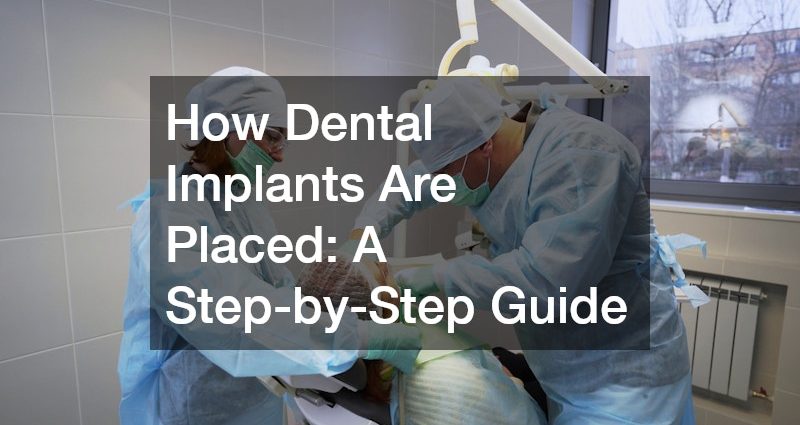
Dental implants have become one of the most reliable and long-lasting solutions for replacing missing teeth. Unlike traditional bridges or dentures, dental implants function like natural teeth, providing both strength and stability. Understanding the process of dental implant placement can help patients feel more confident about the procedure and the results. This guide provides a detailed, step-by-step overview of how dental implants are placed—from initial consultation to the final restoration.
What Is a Dental Implant?
Definition and Components
A dental implant is a small titanium post surgically inserted into the jawbone to serve as an artificial tooth root. Once placed, it supports a custom-made crown, bridge, or denture. Dental implants generally consist of three main components:
-
Implant post: The titanium screw that integrates with the jawbone.
-
Abutment: A connector that attaches the implant to the final restoration.
-
Crown: The visible portion that looks and functions like a natural tooth.
Historical Background
The concept of dental implants dates back several decades, with early attempts involving materials like gold and stainless steel. Modern titanium implants gained popularity in the 1980s due to their biocompatibility and high success rates. Advancements in surgical techniques and imaging technology have further improved outcomes, making implants a common solution worldwide.
Types of Dental Implants
There are two primary types of dental implants:
-
Endosteal implants: Placed directly into the jawbone and the most commonly used type.
-
Subperiosteal implants: Placed on top of the jawbone beneath the gum tissue, often used for patients with insufficient bone height.
Ideal Candidates
Good candidates for dental implants generally have:
-
Healthy gums and sufficient bone density
-
No uncontrolled medical conditions that could impair healing
-
Commitment to maintaining good oral hygiene
Benefits of Dental Implants
Dental implants provide numerous advantages over other tooth replacement options:
-
Long-lasting and durable
-
Preserve jawbone density
-
Function and feel like natural teeth
-
Do not affect neighboring teeth, unlike traditional bridges
How to Prepare for Dental Implant Surgery
Initial Consultation
The process begins with a comprehensive consultation. Your dentist will review your medical and dental history, evaluate your oral health, and discuss your goals for treatment.
Medical Evaluation
Before surgery, a thorough medical evaluation ensures that you are fit for the procedure. Conditions such as diabetes, osteoporosis, or certain medications may require additional planning.
Imaging and Treatment Planning
Dental X-rays and 3D imaging help your dentist assess bone structure, nerve placement, and optimal implant positioning. A personalized treatment plan is developed based on these images.
Pre-Surgery Instructions
Patients are usually advised to avoid eating or drinking for a certain period before surgery. Instructions may also include medication adjustments and oral hygiene guidance.
Timing and Financial Considerations
The timing of implant surgery may depend on whether additional procedures, such as bone grafting, are needed. Costs can vary based on the complexity of the case, number of implants, and type of restoration.
What Happens During Dental Implant Surgery
Anesthesia and Comfort Measures
Dental implant surgery is typically performed under local anesthesia, sometimes combined with sedation. This ensures patients remain comfortable and pain-free during the procedure.
Placement of the Implant
During surgery, the dentist makes an incision in the gum to expose the jawbone. A precise hole is drilled, and the titanium implant post is inserted. The gum is then sutured around the implant.
Post-Placement Procedures
After implantation, patients are monitored briefly in a recovery area to ensure comfort and safety before leaving the office.
Sutures and Healing Caps
Sutures may be used to close the gum tissue, and a healing cap is often placed on the implant to protect it during the initial healing phase.
Surgical Risks and Complications
As with any surgery, risks include infection, bleeding, or nerve irritation. However, these complications are relatively rare and can usually be managed effectively.
What Is the Post-Surgery Recovery Process Like?
Recovery Timeline
Most patients experience mild swelling and discomfort for a few days. Full healing of the gum tissue occurs within a couple of weeks, while the implant integrates with the bone over several months.
Managing Discomfort or Swelling
Ice packs, prescribed or over-the-counter pain relievers, and rest can help manage post-operative discomfort.
Dietary Restrictions
Soft foods are recommended during the initial recovery phase to avoid placing stress on the implant site.
Oral Hygiene Post-Surgery
Gentle brushing and rinsing with antibacterial mouthwash help maintain oral hygiene without disturbing the implant site.
Follow-Up Appointments
Regular follow-up visits allow the dentist to monitor healing and ensure that the implant is integrating correctly with the bone.
How Is the Final Restoration Placed?
Osseointegration Period
The implant must fuse with the jawbone in a process called osseointegration, which typically takes several months. Successful integration is critical for the long-term stability of the implant.
Abutment Procedure
Once osseointegration is complete, the abutment is attached to the implant. This small connector will support the final crown.
Choosing the Right Crown
Crowns are selected to match the color, shape, and size of surrounding teeth, ensuring a natural-looking result.
Placement of the Crown
The final crown is secured to the abutment, restoring both function and appearance.
Maintenance of the Implant
Dental implants require regular brushing, flossing, and dental check-ups to ensure they remain healthy and functional for many years.
The placement of dental implants is a carefully planned and highly effective procedure for restoring missing teeth. From the initial consultation and medical evaluation to surgery, recovery, and final restoration, each step is designed to ensure optimal results. Dental implants offer lasting benefits, including improved oral health, natural function, and a confident smile. With proper care and professional guidance, implants provide a durable and reliable solution that can last a lifetime.


